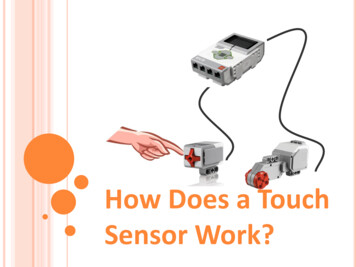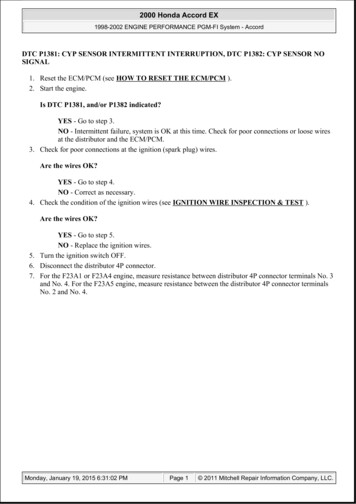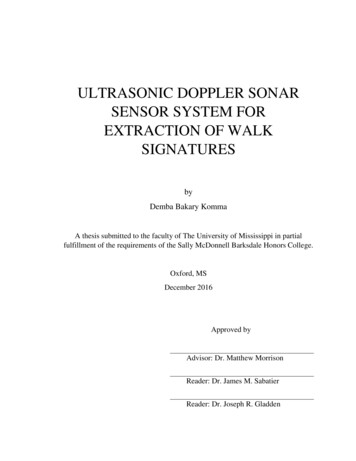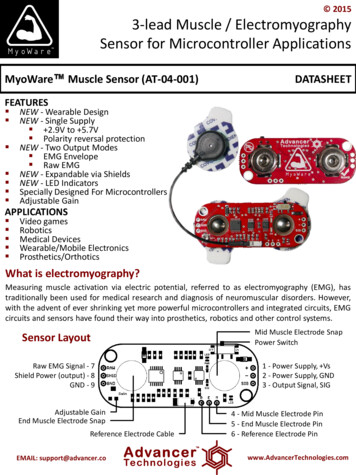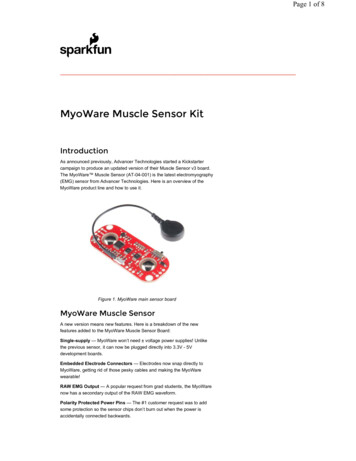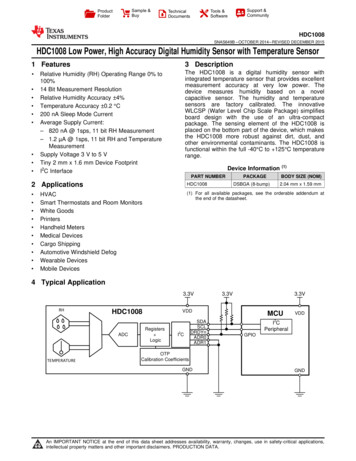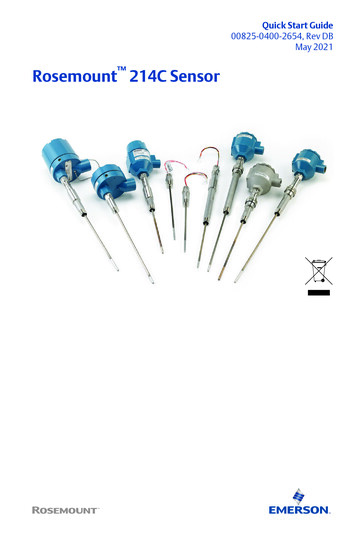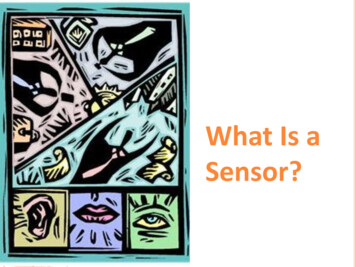
Transcription
What Is aSensor?
What Is a Sensor? Pre-Quiz1.How many sensors or senses do humanshave? List them.2.Describe how any two of the sensors youlisted work.3.Give examples of sensors in robots that aresimilar to at least three human senses.2
What Is a Sensor? Pre-Quiz Answers1.How many sensors or senses do humans have? List them.Five main sensors: eyes, ears, nose, skin, tongue.(Other sensors include: detecting temperature, detecting bodyposition, balance sensors, and blood acidity sensors.)2.Describe how any two of the sensors you listed work.Eyes take in light from the surroundings and relay that to nerve cellsthat send images to the brain. Ears take in sound waves from the air andvibrate, sending vibrations through the inner ear to hair cells that sendsignals to the brain. Particles are inhaled into the nose and nerve cellscontact the particles and send signals to the brain. Sensors all over theskin are activated and send signals to the brain through the nervoussystem. Taste buds on the tongue are made of small cells that have littlehairs that are activated by food particles; these hairs send signalsthrough the nerves to the brain.3.Give examples of sensors in robots that are similar to atleast three human senses.A robot’s light and ultrasonic sensors are like eyes.Sound sensors are like ears. Touch sensors are like skin.3
What is a sensor?Lesson ObjectiveProvide a background in sensors and the context for the use ofsensors in engineering by reinforcing the concept of �Review human senses with more detail than was provided inthe previous unit, followed by a similar review of robot sensors.Then conduct the associated activity, Robot Sensors and Sound.4
What is a sensor?A sensor is a device that measures a physical quantity. Example: When you touch an object, sensors on your fingers sendsignals to your brain so that it measures temperature, and so yourbrain recognizes the object as being hot or cold.The skin in your fingers containsmillions of sensitive nerveendings that can detect stimuli(physical quantities) such astemperature.This stimulus is converted toneuronal impulses that are sentvia nerves to a specific region inthe brain, which interprets it as5being hot or cold.The same happens with pressure and pain signals.
What is a transducer? A sensor is a device that senses or detects a signal. Signals areforms of energy, and a sensor senses a signal by typicallyconverting one form of energy to another. This act ofconverting is also called transducing, and so sensors are alsocalled transducers. So, a transducer is a device that converts one signal to another. Examples: A microphone converts sound to electricity, a carspeedometer converts wheel rotation to a speed reading.These signals are sent to the computer (or the brain). So, a sensor is also called a transducer.Physics and engineering concepts are used to develop a variety of transducers,6which you will learn about later. For instance, a type of pressure sensorconverts strain (stretch) into an electrical signal.
Sensors provide information to makedecisions: from stimulus to responsestimulus sensor coordinator effector responsetouch pain receptor nervous system muscle movementThe sequence of steps above describes what happens when you touchsomething hot—the stimulus is touch, the sensor is the temperaturereceptor on your finger that senses it and relays it to the nervous system(spinal cord and brain), which is the coordinator. The coordinator makes thedecision of how to react, and then commands the hand muscles (theeffector) to jerk back quickly.In summary: We go from stimulus (touch) to response (movement of hand).Do This: Sketch out the stimulus-to-response sequence for how this might beimplemented in a robot. Identify all the components, as in the example7above. (Answers on slide 26)
Human Sensors Your sensory organs (eyes, ears, nose and skin) provide information to yourbrain so that it can make decisions. They work in a manner similar to theworking of robot sensors. Your brain continuously uses the information thatit receives from your sensory organs to make your body function. Five main human senses: Your eyes allow you to see the world Your ears allow you to hear sounds Your skin lets you feel objects through touch Your nose lets you smell the many scents in the world Your tongue lets you taste Plus additional sensors in our bodies that you do not notice directly: Sensors in the inner ear give the brain information about balance Sensors in muscles let the brain know body position Sensors throughout the body that detect temperature and others 8
Human Sensors—Signal TransmissionWhen a human body sensors detect a stimulus, it sends thisinformation through the nervous system (like wires) to the brain.The nervous system has two main parts:The peripheral nervous system is a seriesof branches of single nerves that connectto every sensor in your body. They sendsignals to other nerves, which sendsignals to more nerves until the signalreaches the second part of the nervoussystem, the central nervous system.The central nervous system consists ofyour spinal cord and your brain. Thespinal cord is made of bundles of nerves that are surrounded bybones for protection. Once a signal from a sensor reaches thespinal cord, it is sent up the cord to the brain. The brain decideswhat to do based on the information received.9
Vision: How does the brain understand what we see?1.Light (stimulus) from the objectenters the eye.2.Light sensors convert(transduce) light into anelectrical signal.3.This electrical signal passesthrough the optic nerve to thelateral geniculate nucleus(LGN), which relays theinformation to the visualcortex.4.The visual cortex processes thisinformation and “recognizes”the object seen.10
Vision: How do your eyes work?Light enters the eye, and is refracted (bent) bythe cornea, the outermost part of the eye.Refracted light is directed to the pupil, a smallhole in the center of the iris, the colored partof the eye. The iris changes the pupil size toallow more or less light to enter.Light that goes through the pupil is redirectedagain by the eye’s lens, which points the lightat nerve cells in the back of the eye.Two types of nerve cells in the back of the eye: Cones and rods send signals throughthe optic nerve to the brain.Cones detect colors and fine details in good light.They are concentrated in the center back of the eye.Rods detect the presence of objects in poor light; theyare concentrated on the sides of the back part of theeye.Do This: Brainstorm and write a stimulus-sensor-coordinatoreffector-response pathway for this sensor. (Answers on slide 27)11
Vision: How many light sensors do we have?The cells in your eye that respond to light (that is, the sensorsthemselves) are called rods and cones. Rods cannot distinguish colors, but are responsible for low-lightblack-and-white vision. Cones are responsible for color vision.Millions of rods and cones are present in each of your eyes, and theysend their signals to the visual cortex of your brain. The visual cortex integrates the signals from the rods and cones andassembles the “picture” of the object in your brain, similar to how acamera assembles the various bits of an object into a picture of theentire object.* The rods and cones convert/transduce light energy intoelectrical energy, and send the energy along the opticnerve (similar to wires) to the visual cortex of your brain. *12
Sound: How do your ears work? Sound waves enter the ear canal and cause the eardrum to vibrate. Eardrum vibrations are carried throughthe hammer, anvil and stirrupof the ear to a fluid-filled structurecalled the cochlea. Different pitches cause differentparts of the fluid in the cochlea to vibrate. When cochlear fluid vibrates, it moves hairsconnected to nerve cells, which send signalsto the brain through the auditory nerve. The brain helps you recognize the sound.Do This: Brainstorm and write a stimulus-sensor-coordinatoreffector-response pathway for this sensor. (Answers on slide 28)13
Sound: How many sensors do our ears have?Thousands of neurons in your ears respond to sound. These neurons respond differently to different pitches.Pitches range from low (such as from drums) to high (such asfrom bells). All these signals are sent individually to theauditory cortex in your brain. The auditory cortex integrates all the frequencies correctlyand helps your brain understand the sound (for example,music). This is similar to how a microphone assembles all thesignals of sound and relays it forward.* The neurons in your ear convert/transduce sound intoelectrical impulses, and send them along the auditory nerve(similar to wires) to the auditory cortex in your brain. *14
What is sound?Oscillation of air pressure is felt by humans as sound.When air is pushed repeatedly, as by a speakerdiaphragm, it creates what we call a sound wave.Watch this video to learn more: (5 minutes)NASA “Science of Sound” http://www.youtube.com/watch?v ovMh2A3P5k15
What is sound?Sound is a mechanical wave:Changes in air pressure (vibrations) produce the movement ofair particles. These particles start bumping into the other airparticles, and this causes a wave that travels in all directions.Your ears can detect the wave (as shown in the video).* The mechanical energy in the wave is sensed by our ears andconverted to electrical energy, which is transmitted to theauditory cortex, and our brain recognizes this as sound. *16
Smell: How do we smell using our noses? Small particles of almosteverything around uscan be found in the air. These particles enter thenose when you breathein and contact nerveendings in the uppernasal passage. The nerve endings sendsignals through thenervous system to thebrain, which identifies the smell.Humans can distinguish betweenhundreds of different smells. Dogscan distinguish between thousands.Watch this video on how smell works: (1:49 rks/461-how-smell-works-video.htmDo This: Brainstorm and write a stimulus-sensor-coordinator-effectorresponse pathway for this human sensor. (Answers on slide 29)17
Smell: How many sensors do our noses have? The roof of the nasal cavity has olfactory epithelium at the back. Theolfactory epithelium (about the size of a quarter) contains special receptorsthat are sensitive to odor molecules that travel through the air. These receptors/neurons are very small At least 10 million of them are inyour nose! These neurons respond differently to different odors, and the signals aresent via to the olfactory nerve to the olfactory bulb, which is in front of yourbrain, just above the nasal cavity. Signals are sent from the olfactory bulb to other parts of the brain to beinterpreted as a smell you may recognize. Humans can distinguish between10,000 different smells! Dogs have a much better sense of smell than humans. This is because theyhave 220 million smell receptors, and their olfactory epithelium is about thesize of a saucer!* The neurons in your nose convert/transduce the smell into electricalimpulses, and send them along the olfactory nerve and olfactory bulb(similar to wires) to various parts of your brain. *18
Taste: How do we taste using our tongues?The tongue has sensory receptors called taste buds thatdetect 5 different flavors: sweet, salty, bitter, sour, umamiThe umami flavor is present in many protein foods, such asmeats, cheeses, tomatoes and mushrooms, and is generallydescribed as a savory, meaty taste. Taste buds are comprised of gustatory receptor cells thathave tiny hairs that detect taste from the food you eat. Thehairs send information to the cells, which send signalsthrough the nervous system to the brain, which interpretsthe information as taste.What is the difference between taste and flavor?Flavor includes taste, but also a little more. It comprisestaste, smell, texture and other sensations such as pain fromspicy food. Eating food with your nose blocked showsdecreases its flavor, even though the taste is the same.Do This: Brainstorm and write a stimulus-sensor-coordinator-effectorresponse pathway for this sensor. (Answers on slide 30)19
Taste: How many sensors do our tongues have? Taste receptors are complicated, and scientists are continuing toinvestigate to completely understand our tongues. We know that we can sense five different types of tastes—sweet, salty,bitter, sour and umami—but it is not clear how our tongue distinguishesbetween them. It is believed that we have about 50 to 100 receptor cells per taste. The olfactory bulb integrates inputs from all the receptor cells, and thensends the information to the brain.* The receptors on a human tongue convert/transduce taste into electricalimpulses, and send them along the olfactory nerve to the olfactory bulb andvarious parts of the brain. *20
Taste Activity (20 minutes)What is the difference between taste and flavor? Rememberthat flavor includes taste, but also alittle more. It is composed of taste, smell, textureand other sensations such as pain when you eatsomething spicy. Eating food with your nose blocked shows amarked decrease in flavor, even though the taste isthe same. Let’s demonstrate this using a quick activity thatuses some multi-flavored candies (such as21Starburst) and working in pairs.
Taste Activity StepsMini-activity using Starburst (or other) flavored candies: Divide the class into groups of 2 students each. Give 1 student in each group 2 pieces of candy. Do not tell the otherstudent in the group the flavors given. Blindfold the partner without the candy and have him/her pinchhis/her nose closed. This is the taster. Have the other partner unwrap one piece of candy and give it to theblindfolded taster who chews the candy and guesses the flavor. Then, the taster uses a dry paper towel to wipe his/her tongue dry,and again closes
A sensor is a device that measures a physical quantity. . touch pain receptor nervous system muscle movement The sequence of steps above describes what happens when you touch something hot—the stimulus is touch, the sensor is the temperature receptor on your finger that senses it and relays it to the nervous system (spinal cord and brain), which is the coordinator. The coordinator .
